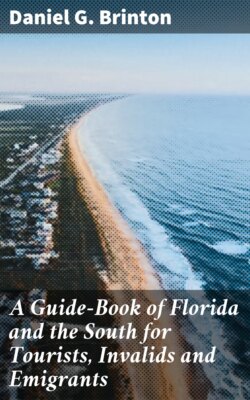Читать книгу A Guide-Book of Florida and the South for Tourists, Invalids and Emigrants - Daniel G. Brinton - Страница 18
На сайте Литреса книга снята с продажи.
Savannah.
ОглавлениеHotels.—*Screven House, Pulaski House, both $4.00 a day. *Marshall House, $3.00 per day, $15.00 per week, an excellent table. *Pavilion Hotel, Mr. Noe. Proprietor; a quiet, pleasant house for invalids, $3.00 per day.
Boarding Houses.—Mrs. McAlpin, South Broad street; Mrs. Kollock, South Broad street; Mrs. Savage, Barnard Street; all $3.00 per day, $14.00 per week.
Post Office and Telegraph Office on Bay street, near the Pulaski House.
Street Cars start from the post office to various parts of the city. Fare, 10 cents; 14 tickets for $1.00. Omnibuses meet the various trains, and steamboats will deliver passengers anywhere in the city for 75 cents each.
Livery Stables are connected with all the hotels.
Restaurants.—The best is the Restaurant Francais, in Whitaker Street, between Bay and Bryan Streets.
Newspapers.—Daily Savannah News, Daily Morning News.
Bookstores.—J. Schreiner & Co., near the Pulaski House. (Brinton’s Guide-Book, Historical Record of Savannah.)
Depots.—The Central Railroad depot is in the southwestern part of the city, corner of Liberty and E. Broad Streets. The railroad from Charleston has its terminus here. The Atlantic and Gulf Railroad is in the south-eastern part of the city, corner of Liberty and E. Broad Streets.
Savannah is situated in Chatham county, Ga., on a bluff, about forty feet high, seven miles above the mouth of the river of the same name, on its right bank. Its present population is estimated at 40,000.
The city was founded by Gov. James Oglethorpe, in 1733. It played a conspicuous part during the Revolution. With characteristic loyalty to the cause of freedom the Council of Safety passed a resolution in 1776 to burn the town rather than have it fall into the hands of the British. Nevertheless, two years afterwards the royal troops obtained possession of it by a strategic movement. In the autumn of 1779 the American forces under General Lincoln, and the distinguished Polish patriot, Count Casimir Pulaski, with their French allies under Count d’Estaing, made a desperate but fruitless attempt to regain it by assault. Both the foreign noblemen were wounded in a night assault on the works. Count Pulaski mortally. The spot where he fell is where the Central Railroad depot now stands.
The chief objects of interest are the monuments. The *finest is to the memory of Pulaski. It is in Chipewa square, and is a handsome shaft of marble, surmounted by a statue of Liberty, and supported on a base of granite. Its height is 55 feet; its date of erection 1853.
An older and plainer monument, some fifty feet high, without inscription, stands in Johnson square. It was erected in 1829, and is known as the Greene and Pulaski monument.
The city is beautifully laid out, diversified with numerous small squares, with wide and shady streets. Broad Street and Bay Street have each four rows of those popular southern shade trees known as the Pride of India, or China trees (Melia Azedarach).
A praiseworthy energy has supplied the city with excellent water from public water works; and, in Forsyth Park, at the head of Bull Street, is a fountain of quite elaborate workmanship.
Some of the public buildings are well worth visiting. The Georgia Historical Society has an excellent edifice, on Bryan Street, with a library of 7,500 volumes, among which are said to be a number of valuable manuscripts.
The *Museum, on the northeast corner of Bull and Taylor streets, contains a number of local curiosities.
The Custom House is a handsome fire-proof structure of Quincy granite.
The Exchange building, now used as the Mayor’s office, etc., offers, from its top, the best view of the city.
Excursions.—Several days can be passed extremely pleasantly in short excursions from the city. One of the most interesting of these will be to
*Bonaventure Cemetery.—This is situated 3 miles from the city, on the Warsaw river. A stately grove of live oaks, draped in the sombre weeds by the Spanish moss, cast an appropriate air of pensiveness around this resting place of past generations. A cab holding four persons to this locality costs $8.00.
Thunderbolt, a small town, (two hotels), 4½ miles south-east of the city, on a creek of the same name, is worth visiting, chiefly for the beautiful drive which leads to it. Cab fare for the trip, $8.00.
White Bluff, on the Vernon river, 10 miles from the city has two unpretending hotels, and is a favorite resort of the citizens on account of the excellent shell road which connects it with the city. Cab fare for the trip, $10.00.
Bethesda Orphan House, also 10 miles distant, is erected on the site chosen by the Rev. Mr. Whitfield, very early in the history of the colony. Selina, the pious Countess of Huntington, took a deep interest in its welfare as long as she lived, and it is pleasant to think that now it is established on a permanent footing.
Jasper Spring, 2 miles from the city, is pointed out as the spot where the bold Sergeant Jasper, with one assistant, during the revolutionary war, surprised and captured eight Britishers, and forced them to release a prisoner. The thoughtless guard had stacked arms and proceeded to the spring to drink, when the shrewd Sergeant who, anticipating this very move, was hidden in the bushes near by, rushed forward, seized the muskets, and brought the enemy to instant terms.
